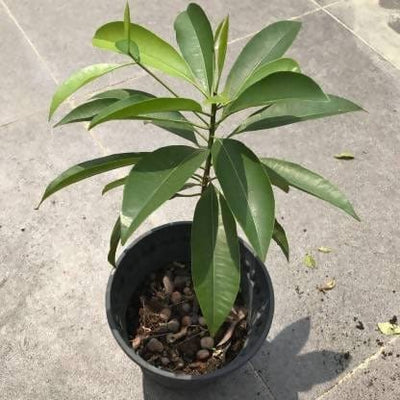Chikoo, Sapota, Chiku Plant
Manilkara zapota, commonly known as the Sapota or Chiku Plantis a long-lived, evergreen tree native to southern Mexico, Central America and the Caribbean. The Sapota when fully ripe is delicious and is eaten as dessert fruit. The pulp is sweet and melting. Besides food values the Sapota fruits are also used in some auverda preparations.
Common Name - sapota, sapote, sapodilla, zapote, sapoti, nispero, dilly, naseberry, chicosapote, and many other names.
Chiku Plant Height - approx 1 feet.
Bloom Time - Rarely bloom.
Maturity Height- Up to 1200 m.
Chiku Plant Care - Plant where they will receive a minimum of 5 to 6 hours of full sun per day. Plants grown in weak sun may not die at once, but they weaken gradually. Give them plenty of organic matter when planting and don, t crowd them.Wear sturdy gloves to protect your hands from prickly thorns.
Sunlight - Part shade to full shade.
Water - Dry to medium.
Soil - Well drained Fertile Soil.
Fertilizer - Apply any organic fertilizer.
Growing Sapota/ Chiku Plant in Containers -
Sapota is a tree that can grow to more than 30 m tall with an average trunk diameter of 1.5 m. Sapota is sweet like a peach. If you want to enjoy it in the house then you can develop it by propagation the Sapota plant. You can germinate Sapota seeds or grafting also
Sapota trees do not grow very well in cold weather, however mature trees tolerate the cold, as long as the temperature is not falling regularly. The fruit of the sapodilla is yellowish-brown and its leaves are shiny evergreen, and the flowers are white Mature sapodilla generally produces fruits twice a year. After 4 to 6 months of flowering, mature Sapota fruits are obtained. Sapota plant requires well-drained sandy soil.
Sapota is grown in a variety of soil but deep alluvial, sandy loam soil and black. soll having good drainage are ideal for doing Sapota farming. Soil pH having 6.0 8.0 is optimum for growing Sapota.
Grafted Sapota plant starts to bear fruits in 2 to 3 years Growing Sapota is not particular when it comes to water requirements. They may do equally well in arid or humid environments, although more severe conditions can result in a lack of fruiting.
Sapota trees grow well in containers as long as you provide an adequate size pot for root development. Select a pot 18 to 24 plus inches in diameter and 20 plus inches in height, with adequate drain holes. Glazed pots need far less watering than raw terracotta pots due to their porous nature.






